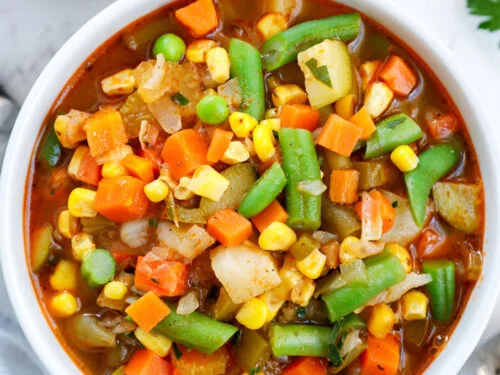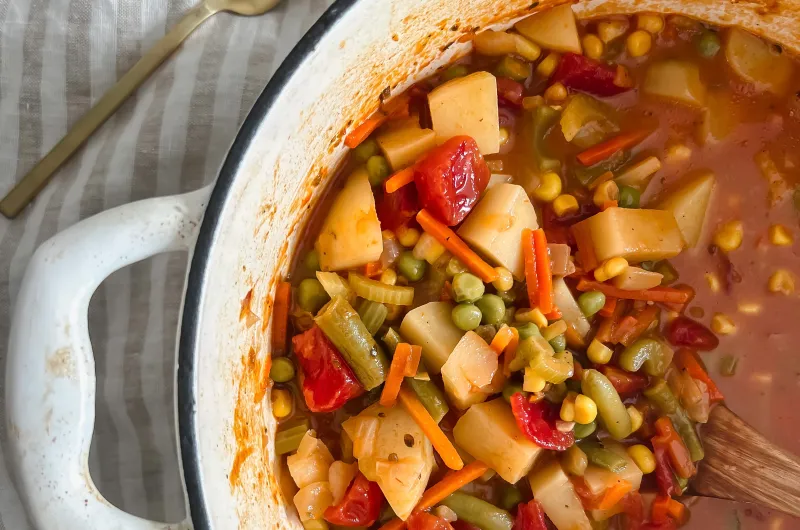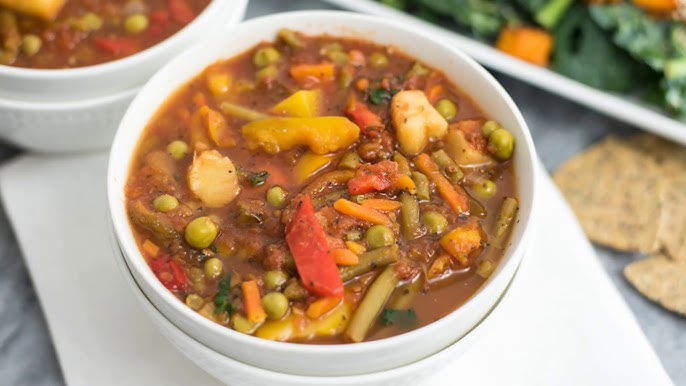Frozen vegetable soup is a nutritious and convenient meal for busy individuals. It offers a quick way to enjoy wholesome ingredients without the hassle of chopping and prepping fresh vegetables.
Packed with vitamins, fiber, and antioxidants, frozen vegetable soup supports a healthy lifestyle while saving time in the kitchen.
Using frozen vegetables ensures consistent quality and year-round availability. Frozen options retain their nutrients through flash-freezing, preserving their taste and texture.
This makes frozen vegetable soup an excellent choice for those seeking a budget-friendly, flavorful, and satisfying dish.
With countless variations, you can customize it to suit your taste. Either a hearty, protein-packed soup or a creamy, comforting bowl, there is a recipe for any choice you prefer.
This content explores the benefits, recipes, and preparation techniques to help you create delicious frozen vegetable soup effortlessly with a warm, nourishing meal with minimal effort.
Benefits of Frozen Vegetable Soup

Frozen vegetable soup offers a range of benefits, making it a practical and nutritious meal option. From high nutritional value to cost-effectiveness, it provides a convenient way to enjoy a wholesome diet without compromising on taste or quality.
1. Nutritional Value
Frozen vegetables retain most of their vitamins, minerals, and antioxidants due to the flash-freezing process. Unlike fresh produce, which may lose nutrients during transportation and storage, frozen vegetables maintain their nutritional integrity.
This ensures that your soup remains rich in essential nutrients like vitamin C, fiber, and potassium. In addition, frozen vegetables contain fewer preservatives and additives than many canned options, making them a healthier choice.
Many frozen vegetables are harvested at peak ripeness, ensuring maximum nutrient density. This makes frozen vegetable soup an excellent option for those looking to boost their daily intake of essential vitamins and minerals. Since vegetables are the primary ingredient, the soup is naturally low in calories while being high in fiber, which supports digestion and promotes fullness.
2. Convenience and Time-Saving
One of the biggest advantages of using frozen vegetables is the time saved in meal preparation. Since frozen vegetables come pre-chopped and pre-washed, they eliminate the need for peeling, dicing, or washing, significantly reducing prep time. This is especially beneficial for individuals with busy schedules who still want to enjoy a home-cooked meal.
Frozen vegetable soup also allows for flexible meal planning. You can keep a variety of frozen vegetables in your freezer and prepare a healthy soup whenever needed. Unlike fresh vegetables, which may spoil within days, frozen vegetables have a longer shelf life, reducing food waste.
3. Cost-Effectiveness
Buying frozen vegetables is often more affordable than purchasing fresh produce, especially for out-of-season varieties. Since frozen vegetables are available year-round at stable prices, they help reduce grocery costs while maintaining quality.
Additionally, using frozen vegetables minimizes waste since you can use only what you need and store the rest for later. This makes frozen vegetable soup an economical choice for families or individuals looking to stretch their food budget without compromising nutrition.
Incorporating frozen vegetable soup into your diet ensures a balance of nutrition, convenience, and affordability. It’s a simple yet effective way to maintain a healthy lifestyle without spending extra time or money on fresh ingredients.
Read More
Root Vegetable Soup Recipe
Weight Watcher Vegetable Soup
How to Make Frozen Vegetable Soup

Making frozen vegetable soup is simple, quick, and adaptable to different tastes and dietary needs. Choosing the right ingredients and cooking methods ensures a flavorful, nutrient-rich meal. Whether you prefer a light broth-based soup or a hearty, creamy version, frozen vegetables make preparation effortless. Here are the steps to follow:
1. Choosing the Right Ingredients
The foundation of a delicious frozen vegetable soup lies in selecting high-quality ingredients. While most frozen vegetables work well in soups, some perform better in other foods.
Best Vegetables for Soup: Peas, carrots, corn, green beans, spinach, broccoli, and bell peppers hold their texture and flavor after freezing. Root vegetables like potatoes and sweet potatoes also work well but may require longer cooking times.
Herbs and Spices: Seasoning enhances the soup’s flavor. Garlic, onion, thyme, basil, and bay leaves complement most vegetable combinations. For a spicier version, chili flakes or cayenne pepper can add heat.
Broth or Base: Vegetable broth, chicken broth, or even water with added seasonings can serve as the soup’s base. Using homemade stock enhances flavor and nutrition.
Adding protein sources like beans, lentils, or tofu can make the soup more filling. Grains like quinoa, rice, or barley add texture and substance. A well-balanced frozen vegetable soup includes a mix of colorful vegetables, protein, and healthy seasonings.
2. Cooking Methods
Cooking frozen vegetable soup is easy, requiring minimal effort. Different methods offer flexibility depending on available time and kitchen equipment.
Stovetop Method: Heat oil or butter in a pot over medium heat. Sauté garlic and onions until fragrant. Add frozen vegetables and cook for a few minutes. Pour in broth and bring to a boil. Reduce heat and let simmer for 15-20 minutes. Season with salt, pepper, and preferred herbs.
This method works well for quick, weeknight meals and allows flavors to develop naturally.
Slow Cooker Method: Place frozen vegetables, broth, and seasonings in a slow cooker. Cook on low for 6-8 hours or high for 3-4 hours. Stir occasionally and adjust seasoning before serving. A slow cooker enhances the depth of flavor and allows for hands-off cooking.
Instant Pot Method :Use the sauté function to cook garlic and onions. Add frozen vegetables, broth, and spices. Seal the lid and cook on high pressure for 5-7 minutes. Release pressure and stir before serving.
This method delivers a rich, flavorful frozen vegetable soup in minutes, making it perfect for busy schedules.
Frozen vegetable soup offers endless possibilities for customization. By choosing the right ingredients and cooking method, you can prepare a nutritious, comforting meal with minimal effort. Whether using a stovetop, slow cooker, or Instant Pot, the process remains simple and rewarding.
Best Frozen Vegetable Soup Recipes

Frozen vegetable soup is incredibly versatile, allowing for countless variations to suit different tastes. Whether you prefer a light broth-based soup or a rich, creamy version, these recipes offer delicious options for any occasion.
1. Classic Mixed Vegetable Soup
This simple, nutritious soup highlights the natural flavors of frozen vegetables.
Ingredients:
- 2 cups mixed frozen vegetables (peas, carrots, corn, green beans)
- 4 cups vegetable broth
- 1 onion, chopped
- 2 cloves garlic, minced
- 1 teaspoon thyme
Salt and pepper to taste
Instructions:
- Sauté onions and garlic in a pot over medium heat.
- Add frozen vegetables and stir for a minute.
- Pour in broth, add seasonings, and bring to a boil.
- Reduce heat and simmer for 15 minutes.
2. Hearty Lentil and Frozen Vegetable Soup
This protein-rich soup is filling and nutritious.
Ingredients:
- 1 cup dried lentils, rinsed
- 2 cups frozen vegetables
- 4 cups vegetable broth
- 1 teaspoon cumin
- ½ teaspoon paprika
Instructions:
- Combine all ingredients in a pot.
- Bring to a boil, then simmer for 25-30 minutes.
3. Creamy Frozen Vegetable Soup
A smooth and comforting soup with a rich texture.
Instructions:
- Follow the classic soup recipe.
- Blend half the soup and mix it back in.
These recipes showcase the versatility of frozen vegetable soup, making it easy to prepare a nutritious meal in minutes.
Tips for Enhancing Flavor and Texture
Making frozen vegetable soup flavorful and satisfying requires a few simple tricks. Since frozen vegetables can have a softer texture, careful preparation ensures a well-balanced soup with great taste.
1. Preventing Mushy Vegetables
Frozen vegetables cook faster than fresh ones. To avoid overcooking, add frozen vegetables toward the end of the cooking process. Use larger-cut vegetables, which hold their shape better. Simmer on low heat instead of boiling aggressively.
2. Boosting Flavor Naturally
Frozen vegetable soup benefits from layered seasoning. Consider these techniques such as Sautéing Aromatics which involves cooking onions, garlic, or ginger before adding broth enhances depth. Also, using fresh herbs by adding parsley, basil, or cilantro before serving brightens the flavor and lastly, adds Acidity by adding a splash of lemon juice or vinegar to balance richness.
3. Increasing Protein and Hearty Texture
To make the soup more filling, stir in beans, lentils, or chickpeas for plant-based protein. Add shredded chicken or tofu for extra substance. Include quinoa, barley, or pasta for a thicker consistency.
Storing and Reheating Frozen Vegetable Soup
Frozen vegetable soup is perfect for meal prep, but proper storage and reheating maintain its taste and texture.
Freezing and Storing
Let the soup cool completely before freezing. Store in airtight containers or freezer bags to prevent freezer burn. Label containers with the date to track freshness. Use within three months for the best flavor.
Reheating Without Losing Quality
Thaw in the refrigerator overnight before reheating. Heat on the stovetop over low heat to avoid overcooking. Stir occasionally and add a bit of broth or water if the soup thickens too much.
Proper storage and reheating ensure frozen vegetable meal remains delicious, nutritious, and convenient for future meals.
Conclusion
Frozen vegetable soup is a simple, nutritious, and budget-friendly meal that fits into any lifestyle. It provides essential vitamins, saves time in the kitchen, and reduces food waste. With the right ingredients, cooking methods, and storage techniques, frozen vegetable becomes a go-to dish for busy days.
By customizing flavors, adding proteins, and using proper reheating methods, anyone can enjoy a delicious, homemade soup with minimal effort. Whether you prefer a classic broth-based recipe or a creamy variation, frozen vegetable soup offers endless possibilities. Keep a few bags of frozen vegetables in your freezer, and you’ll always have the ingredients for a comforting, healthy meal.
